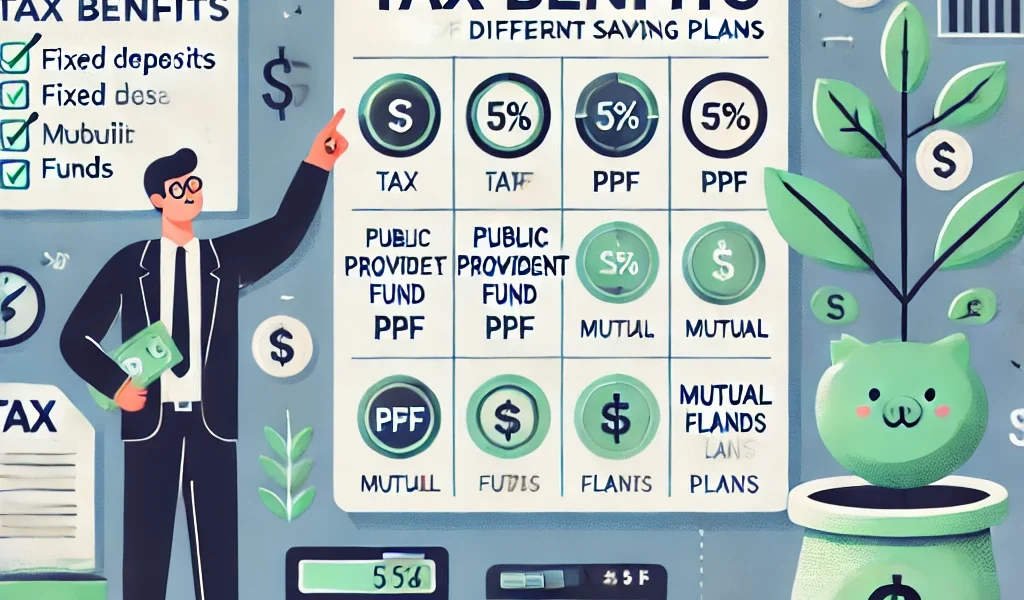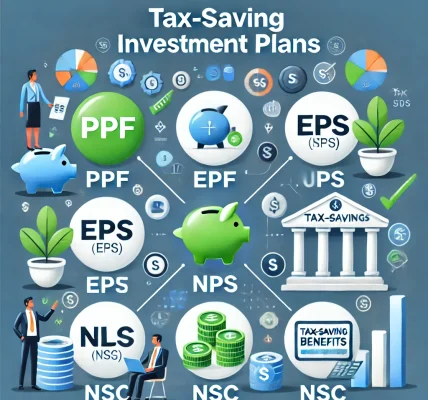Introduction
Saving money is a fundamental aspect of financial planning, and choosing the right saving plan can help you maximize your returns while enjoying tax benefits. Governments often encourage individuals to save by offering tax deductions and exemptions on various investment instruments. Understanding these benefits can help you optimize your savings strategy while reducing your tax liabilities.
In this guide, we will explore different saving plans and the tax benefits associated with them, helping you make informed financial decisions.
Understanding Tax-Saving Investments
Tax-saving investments fall under different sections of tax laws, allowing you to reduce taxable income and grow your wealth. The most common tax-saving sections include:
- Section 80C: Covers investments like PPF, EPF, NSC, and ELSS, offering deductions up to a specified limit.
- Section 80D: Provides deductions on health insurance premiums.
- Section 10(10D): Offers exemptions on maturity proceeds of insurance policies.
- Section 80CCD: Encourages retirement savings through schemes like NPS.
By utilizing these sections effectively, you can minimize your tax burden and enhance your savings.
Best Tax-Saving Saving Plans
1. Public Provident Fund (PPF)
- Tax Benefit: Contributions qualify for deductions under Section 80C.
- Exempt-Exempt-Exempt (EEE) Status: Interest earned and maturity proceeds are tax-free.
- Lock-in Period: 15 years (with partial withdrawals allowed after 5 years).
- Best For: Long-term savings and retirement planning.
2. Employee Provident Fund (EPF) & Voluntary Provident Fund (VPF)
- Tax Benefit: Employee contributions qualify under Section 80C.
- Tax-Free Returns: Interest earned (up to a specified limit) is tax-exempt.
- Withdrawal: Tax-free if withdrawn after 5 years of continuous service.
- Best For: Salaried individuals seeking long-term tax-efficient savings.
3. National Savings Certificate (NSC)
- Tax Benefit: Investment qualifies for Section 80C deduction.
- Interest Taxation: Earned interest is taxable but eligible for further deduction.
- Best For: Risk-averse investors looking for fixed returns.
4. Equity-Linked Savings Scheme (ELSS)
- Tax Benefit: Contributions qualify for Section 80C deduction.
- Lock-in Period: 3 years (shortest among tax-saving investments).
- Capital Gains: Long-term capital gains up to a certain limit are tax-free.
- Best For: Investors looking for market-linked returns with tax benefits.
5. Sukanya Samriddhi Yojana (SSY)
- Tax Benefit: Contributions qualify under Section 80C.
- EEE Status: Interest and maturity proceeds are tax-free.
- Lock-in Period: Until the girl child turns 21 (partial withdrawals allowed after 18 years).
- Best For: Parents saving for their daughter’s education and marriage.
6. National Pension System (NPS)
- Tax Benefit: Contributions under Section 80CCD(1) and 80CCD(1B) (additional deduction).
- Tax-Free Withdrawal: 60% of corpus tax-free at maturity; 40% must be used for annuity.
- Best For: Individuals planning for retirement with tax-efficient growth.
7. Fixed Deposits (Tax-Saving FD)
- Tax Benefit: Qualifies for Section 80C deductions.
- Lock-in Period: 5 years.
- Taxable Interest: Interest earned is taxable.
- Best For: Conservative investors looking for secure returns.
8. Life Insurance Policies
- Tax Benefit: Premiums qualify for deduction under Section 80C.
- Maturity Taxation: Payouts are tax-free under Section 10(10D), subject to conditions.
- Best For: Individuals looking for financial protection with tax savings.
9. Health Insurance (Section 80D)
- Tax Benefit: Deductions on premiums paid for self, family, and parents.
- Best For: Individuals seeking financial security against medical emergencies.
10. Government Bonds & Post Office Savings Schemes
- Tax Benefit: Some bonds offer tax-free interest.
- Best For: Risk-averse investors seeking stable tax-efficient returns.
How to Maximize Your Returns with Tax-Saving Plans
1. Diversify Your Investments
- Combine long-term and short-term savings plans for balanced tax benefits and liquidity.
- Example: PPF for long-term tax-free growth + ELSS for market-linked growth.
2. Use the Full 80C Limit
- Maximize your annual deduction limit by investing in multiple eligible instruments.
- Example: Split investments across PPF, EPF, and NSC.
3. Opt for Tax-Free Interest Plans
- Choose plans with EEE benefits (PPF, SSY, EPF) for tax-free growth.
4. Plan for Retirement Early
- Invest in NPS and EPF for long-term tax benefits and financial security.
5. Leverage Health Insurance Benefits
- Take advantage of Section 80D deductions to reduce taxable income.
6. Invest in ELSS for Higher Returns
- If comfortable with risk, ELSS provides market-linked returns with tax savings.
Conclusion
Choosing the right tax-saving investment is crucial for maximizing your savings and returns. By understanding the tax benefits associated with various saving plans, you can optimize your financial planning and reduce your tax liability. A combination of tax-efficient instruments like PPF, NPS, and ELSS can help you achieve both short-term and long-term financial goals while enjoying substantial tax savings.
Start planning today and make informed investment decisions to secure your financial future with maximum tax benefits!



